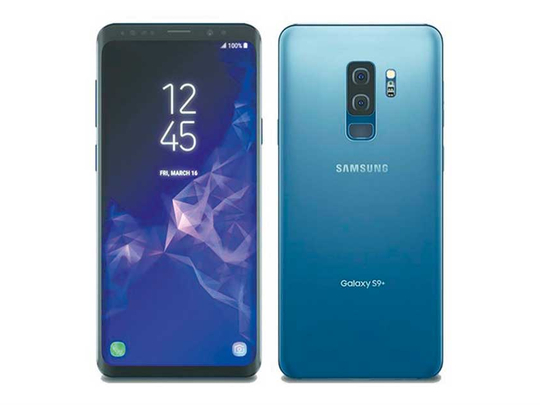
Dubai: The first flagship of the year — Galaxy S9+ — is an excellent Android smartphone and the best from Samsung so far.
It hasn’t changed the design when compared to last year’s S8+ model but it is the hardware, camera and software that makes it stand out from the crowd.
The 6.2-inch Quad HD and curved super AMOLED infinity display with 18.5:9 screen ratio is the best in the industry. It has 529 pixels per inch density and weighs 189 grams compared to 173 grams of S8+.
By reducing the top and bottom bezels a bit, S9+ is a bit shorter than the S8 Plus.
The device sports 6GB of RAM and 64GB of ROM and the microSD card supports up to 400GB. It is powered by home-grown 2.7GHz Exynos 9810 chip set and runs on Android Oreo 8.0 out of the box and not with 8.1 version.
Samsung introduced the biometric logins last year with S8 and S8+ but with S9 devices, it is calling it intelligent scan which means that the device can be unlocked by two methods instead of forcing the user to choose either one. If iris scan needs help, facial recognition will come into play and vice versa.
Samsung has improved iris and facial scan and it is quite faster and more accurate.
There are six ways to unlock the device — iris, face, fingerprint, pattern, password and PIN.
The good thing Samsung has done and heard users’ complaints is that the fingerprint sensor is moved from the side of the camera to bottom of the camera for better reach. It has also stuck to the 3.5mm headphone jack and microSD slot.
The stereo speakers are now tuned by AKG and Dolby Atmos surround sound to have a more immersive experience than previous handsets.
The AI voice assistant — Bixby — has improved this time with translation, location-based landmarks, QR code scan and calorie of the food you shoot. Some features are hit and miss. It still needs fine-tuning.
The camera is where the S9+ excels. This is the first Galaxy phone with dual cameras on the rear and the first with the wider aperture to excel in very lowlight conditions.
The 12MP wide-angle lens with a dual aperture (F/1.5/F2.4) and telephoto 12MP autofocus sensor (F/2.4) has dual optical image stabilisation, phase detection autofocus, 2x optical zoom and LED flash.
The lens behaves like a human eye with F/2.4 for daylight pictures and F/1.4 to capture more light and details for low light images.
The camera produces very good shots in any conditions with bright and vivid colours and good exposure, with a very wide dynamic range.
In a comparative study with iPhone X and Google Pixel 2 XL, S9 had better noise-free photographs in low light than iPhone X and matches with Pixel 2 XL, even though it has a single lens. Samsung’s zoom images are much cleaner also.
It can record 2160p (4K) at 60 frames per second, 1080p at 240 frames per second, 720p at 960 frames per second and HDR.
The super slow-motion capture, first on a Samsung phone captures 0.2 seconds of recording at 960 frames per second and plays back in six seconds of each shot but the feature is limited to 20 shots per video. It automatically detects the object in the frame of the camera and starts recording automatically. The slow-motion video can also be recorded manually but the user needs to press the button. It records slow-motion videos in 720p.
The 8MP front-facing autofocus camera with f/1.7 aperture takes decent snaps even in lowlight conditions. It can record 1440p at 30 frames per second, and auto HDR. It is similar to S8+.
The other added feature is the Augmented Reality Emoji, similar to Animated Emoji on iPhone X. It is a fun feature but it does not have the depth as iPhone X.
It uses the 8MP front-facing camera to turn the selfie into an emoji by scanning your facial expressions in 3D and creates 18 different emojis of the person. When I scanned my face with a beard, my avatar was totally a different person without a beard.
The user can change the gender, colour of the face and clothes, with or without specs and hairstyles. The user can use the avatar to record videos with talking, singing and share it with friends. It supports third-party messaging and not like Apple for only iMessage. In my view, AR Emoji is unpolished and needs work.
Regarding connectivity, Bluetooth 5.0, 1.2GBPs LTE speed, Wi-Fi 802.11 a/b/g/n/ac, dual-band, Wi-Fi Direct, hot spot, NFC and GPS.
The battery size of 3,500mAh is the same as last year’s S8+, which means it is difficult to get a full day of use for a heavy user but for moderate users, you can get one full day. It gave just more than six hours of videos on 4G LTE at full brightness.
It comes in midnight black, coral blue, titanium grey and lilac purple. The S9 with 64GB is priced at Dh3,099, 128GB for Dh3,299 and 256GB for Dh3,499. The S9+ with 64GB is priced at Dh3,499, 128GB for Dh3,699 and 256GB for Dh3,899. It will be available from March 16.
Verdict
For Galaxy S8 and Note 8 users, the changes made on S9 may not be much but for people who are using two-year-old Galaxy devices, it is a dramatic jump. At the same time, the prices of S8 and S8+ models will also get a price cut.
How does it score?
Pros
• Fast wireless charging
• First dual cameras on Galaxy phones
• First dual aperture cameras on a phone
• Visible user experience enhancements
• Improved biometric logins
Cons
• Similar design as last year’s S8+
• Gimmicky AR Emoji
• Highly priced for top-end models
• Bixby needs more work to do
• Running on older Android OS out of the box











